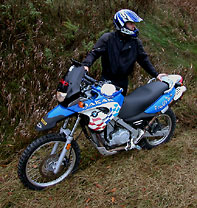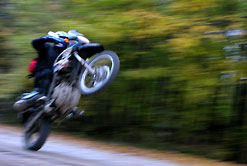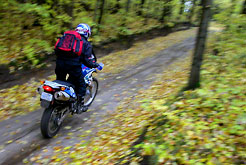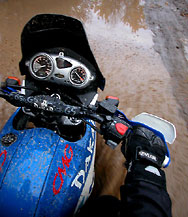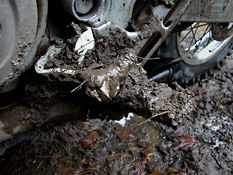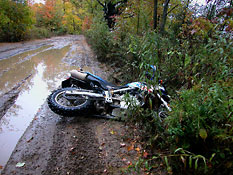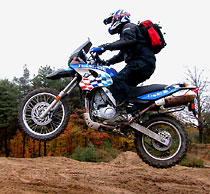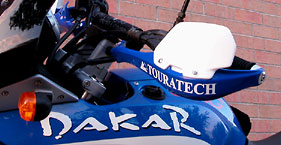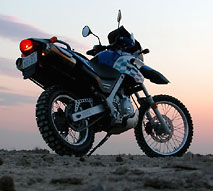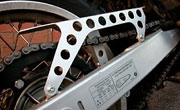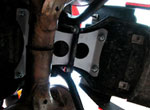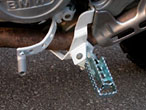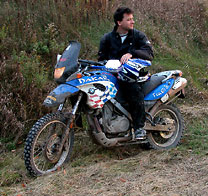|
||||||||||||||||||||||||||||||||||||
|
|
||||||||||||||||||||||||||||||||||||
BMW F650GS DAKAR, LONG TERMER - PART THREE THE
DAKAR GETS DIRTY
By Andrew Boss
CMG has had the BMW F650GS Dakar for half a year, over which time it’s racked up 7,000km and has proven itself to be an excellent road bike and a capable adventure tourer. Well, it did for ‘arris and Mr. Seck, anyhow, who took it on their fancy-pants trip to B.C., drinking red wine (cue Mr. Seck: "I find this Cabernet cloying," responds ‘arris, "You’re mistaking cloying for lardy, old chum." Much laughter and cigar smoking ensues), riding the Coastal Mountains, and pretending not to peek while luxuriating at the hot springs. Of course, my exposure to the Dakar was limited to the memorable Ride For Sight, which was a combination of rain, hail, fast rivers, submerged motorcycles, firemen, teen girls eating ice cream (in an agreeably suggestive fashion), cows, shot-gunned beers, and eventually (at the RFS grounds), shotgun pipes. And then I had to ride all the way back! If you haven’t gone back and read the link, or for those of you who have yet to memorize my enchanting text, I will summarize: I fell down—a lot. Some stuff broke, but I wielded my only defence—the Dakar was fitted with the stock dual-sport tires. CHANGE IS GOOD
So, 7,000km later, we had finally replaced the worn stock tires with a set of Pirelli MT21s. Never underestimate the value of good and proper rubber (Mr. Seck and his droopy collarbone found that one out). After bulldogging their bikes up and down trails, most dual-sporters soon learn the sacred mantra: "90-10, 90-10." That refers to a tire that is rated 90% Off-road and 10% Road use. Pirelli’s MT-21 series fits this bill—an aggressive pattern provides grip off-road, while the composition provides excellent durability. Although these tires usually last slightly less than the dual-sport tires they replace, you can still expect thousands of kilometers of usage. But that's not all we did. We also tricked the folks at Touratech into supplying us with some keen accessories that are allegedly Andrew proof. We got a goodie bag that included bash bars, bar risers, foot peg kit (that included a folding shift lever), a replacement rear brake lever, minimalist countershaft and chain guards, flexy signals, and a brace for the rear fender. (For all the installation poop, see Mr Seck's blurb below). Now we would find out if the Dakar graphics on the tank held promise, or would simply disappoint like a Cavalier Z-24. THE 90-10 TEST
Since there was no Ride For Sight—The Late Fall Edition with which to retrace our original route, we opted instead to head to the Ganaraska forest, just east of Toronto. We being me and the always entertaining Mr. Seck, whose duties included photographic documentation and keeping up on my ageing Honda XL600. The MT-21s on the Dakar were initially filled to a cautionary 26psi. That’s fairly high for off-road use, but it would help protect a rim if nailing something at high speed (now we decide to use caution?). The terrain for the day ran the gamut from wet/dry clay, soft sand, gravel, and as always, muck. The Pirelli’s allowed the Dakar to climb and plow through the deep sand with no fear of getting stuck. It’s still not that pleasurable though, as the Dakar's heft makes you work extra hard to keep it upright. Only when the surface got a little harder did the tires and bike feel truly happy.
Where twisting the throttle would normally yield wheelspin on the stock tires, the knobs helped keep the momentum going. This is especially helpful when you’ve made a mistake and found yourself off the pace on some tight uphill/corner combo. In which case, cranking the throttle and letting that four-stroke torque gu-gu-gu you to the top as the rear tire digs in, does the job. Now all this forward motion is great, but if the front tire is sliding along in a different trail than the rear, you will eventually meet an unhappy ending. In the trails, the front Pirelli inspires confidence unheard of with the stock tires. However, it provided some moments of fear on greasy clay, until we lowered the pressure to about 12psi. Just remember kids—lower pressures provide more grip off-road. Just use caution when at high speed, as a square edged hole can damage a rim—and remember to up the psi when you get back on the street.
While the height and heft of the Dakar would not allow for abrupt directional changes, changing lines and sticking to them became much easier. Sandy, whooped out sections were actually fun. The tires would help the Dakar track straight, and the suspension let you concentrate on getting into a rhythm. Anytime you can keep any bike from plowing the front end you will be able to ride with more confidence and enjoyment. If you can only afford one tire, get the front. I would be remiss not to mention the runny nosed gents we met up with on a new Honda XR650R and a Kawasaki KX250. These guys warned us that as we headed east we were in for some nasty, near impassable muck stuff that made them turn around. That’s all we needed to hear to go for it. We railed it man! Along with my beloved XL600R too! Hey, when we do have successes, please don’t deny us exploiting them. On the highway the tires are marginally louder and a negligible vibration is imparted though the bars. Just remember, they won’t stick like the stockers on pavement during high-speed hi-jinks. You will however be rewarded with much more enjoyable off-road experiences though. THE TOURATECH TEST
The folks at Touratech actually prep and equip bikes for the authentic Dakar race, so there’s no sissy form-over-function stuff here. The signals were my bane in the Ride for Sight, as I snapped the brittle stockers off with cold, damp enthusiasm, which usually took the form of falling over exhausted at low speeds. The Touratech signals appear to come from the same people that manufacture Gummy Bears. If there were a more flexible signal on the market, it would be made of liquid. Snapping these buggers off would require something heroic, dramatic, and likely require a chiropractor for re-hab. The bash bars fit the stock bars cleanly with no modifications, despite all the doo-dads that are kept there. They helped immensely on the one occasion where I nailed a tree with the left bar. I could still ‘hand model’ jewellery on ‘The Price Is Right,’ if they would ever return my calls.
Handlebar risers offering a height increase of 1 1/2" inches combined with snazzy footpegs that were longer and wider than stock and allowed for improved ergonomics, particularly aiding my ability to comfortably stand on the Dakar for extended periods. This comes in handy when the off-road pace quickens, helping conserve some energy. The Dakar weighs 426lbs wet so you already have enough to worry about. The folding shift lever is a tasty looking lightweight item. Happily, its elastic properties were up to the task when Mr. Seck folded it backwards onto itself. This was done midway through a giant muck hole. Seems this muck hole wasn’t familiar with the old adage of "Just give ‘er." Note to Touratech: CMG requires levers that fold in about three different spots. The rear brake lever was a non-folder that was tucked so close to the cases it was hard to get a boot on it. As our test time was short we didn’t adjust it to suit, but we didn’t fold it over backwards either. At CMG, that is a little victory.
The countershaft and chain guards provided are attractive replacements over the stock items. I’m not sure of the chain guard’s necessity, but the countershaft cover allows you to see if the gear shaft is getting tangled with weeds. And both items did look bitchin’ on the bike. Thankfully we didn’t wreck these. Bracing the rear fender is said to cure a wiggle that is more profound when the pace picks up. Despite that imagery, no wiggling was evident. Mr. Seck blamed his wipe out on trying to view the braced rear fender’s response to the high-speed muck hole. What CMG won’t do in order to serve you better. Well, CMGRC members, anyway. At 5’11" with a 30.5" inseam (yup, I checked) the Dakar is tall with its 34" seat height. Mr. Seck, 6’2" (he can check his own inseam, thanks) felt very comfortable and confident, despite the excursion through the muck hole.
While all these modifications could be performed on a standard F650GS with its lower 30.7" seat height, you would lose 1.5" of suspension travel over the Dakar and that beautiful paint scheme. Being a vain, sad little man, who knows the value of an inch, I would stick with the Dakar and go with the BMW’s optional low seat. My dilemma is solved. Overall, what we learned is that with some simple but thoughtful changes, the Dakar’s off-road potential can be exploited, while still delivering a fun, comfortable road manner, along with adventure touring capabilities. Now that I have dutifully enlightened you, I am compelled by the omnipresent Editor ‘arris demands to know whether I, Mr. dirt biker, liked it or not …. dramatic pause … oh yes! This homage to the Dakar race may be edging closer to a dual-sport ‘ideal.’ People in Europe seem to grasp the concept of owning one bike that does everything pretty well. Mind you they also eat mayonnaise on their French fries and wear ponchos while smoking cigarettes that smell like burning tires (not to be confused with the more pleasurable smoking of tires), so maybe we should make our own judgements. But I think I’m starting to get it. TOURATECH
BOLT-ON?
When the Touratech package arrived at the gleaming twin-towers of CMG’s head office, smack-dab in the centre of the universe, discussions ensued - should we attempt to install these goodies on the Dakar ourselves? After all, both Editor ‘arris and myself have done time in the wrenching world, but those were the old days. When I mentioned that there was a possibility that Editor ‘arris may break one of his meticulously manicured nails, well that was the clincher, "just call Pat at Bavarian Motosports and see if you can talk him into doing it for us", was the final decree. Luckily for us, Pat was agreeable, and to ensure he continues to be happy, it seems apt that we start this section with a lovely photo of Chuck torquing the nut on the front axle of the Dakar (Bavarian logo, artfully placed in the background of the frame). The world of aftermarket motorcycle parts is huge, claims of performance improvements are often exaggerated, and everything is supposed to "bolt right on in your own back yard". So what about this Touratech stuff then? How hard can it really be to bolt on all these shiny bits? After all, they don’t look that complicated and there's even a full set of instructions. Ooops! "Does anyone read German around here?". That’s right, it's a full set of German-only instructions. Sigh. Well at least they include some photocopied photos with arrows pointing to all the important bits.
Undaunted, Chuck and I got busy removing the stock bits. We started with something easy - the front sprocket cover. A couple of bolt swaps later and we were done. One of the bonuses of this new cover over the stock, we discovered, is that it allows access to the oil filter without need for cover removal first, unlike the original. After our first success, we opted to jump right into the deep-end and go for the peg, shifter, and brake pedal swap. Thankfully, this also went relatively well with the exception of the right peg that required some work on the grinder in order to get it to sit flat. The peg bracket on the shifter side was also a tight fit and required some jiggling of the pipe so that there would be no contact when the pipe is vibrating, with the engine running. Chuck knows his stuff, but all this jiggery-pokery (tip of the hat to Editor ‘arris there) does take time. This is important to note if you attempt a job like this yourself, or wonder why your bill at the shop for a few "bolt-on" items is so hefty.
Installing the flexible turn signals could have been a problem, because the the new signal looked like the wiring needed to be spliced into the main harness. Fortunately, we discovered that the original wiring could be disconnected from the stock bulb socket, pulled out from the signal, and then inserted into the new signal housing relatively easily. Easy, if you are Chuck at least. Who knows, maybe this handy tip is actually included in the Deutch instructions? I could go on in more detail. But I may be losing a few of you already. To quickly summarize, the rest of the installation; the bar risers, hand guards, and the fender bracket were a bitch to install. Only the nice shiny bits, that don’t do much other than look good, were a piece of cake to install.
Interestingly, when the Touratech hand guards are in place, you lose the bar end weights, making for a narrower, yet potentially buzzier feel at the bars. This stuff is meant for doing serious off-roading however, so losing a few inches of bar width in the tight stuff can be a blessing. As for the buzzing in the bars, what are you, a wus? The tire installation is worth mentioning as well. Hauling the wheel off the back of the Dakar is a pain. On the upside however, Chuck was impressed by how easily the MT21s were to replace over the stock rubber. Worth noting if you have to do some trailside tire patching. All in all it took the better part of a day to install all these goodies, but at the end of the day the Dakar looked eff’n cool and ready for a serious off-road romp! Thanks Chuck. Thanks Pat. Want more info and pricing on these and more Touratech items? Check out: www.touratech-usa.com. Oh, and Pirelli of course: www.ca.pirelli.com.
THANKS TO:
BMW CANADA - for providing the bike and arranging the required shipping. TOURATECH - for all the bolt-on goodies. PIRELLI - for the set of MT-21s BAVARIAN MOTOSPORTS - for the service work and fitting the Pirellis and Touratech stuff. |
||||||||||||||||||||||||||||||||||||
|

